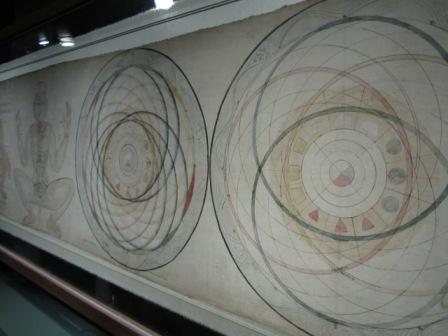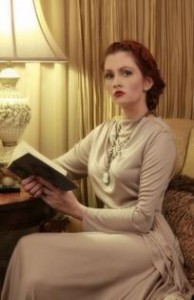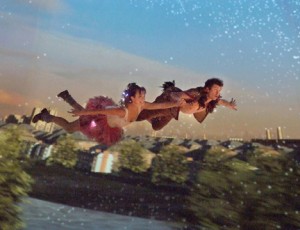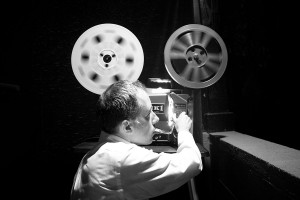by Melanie Crew
Contributing Writer
Emory Cinematheque offers art-house films to the masses! They’re available to the critics, film-students and all film-lovers alike! Their retro-tastic line-up of critically-acclaimed films, all screened in 35mm, is available free to the public every Wednesday night during each semester’s series. Their Spring 2014 ‘Global French Cinema’ series runs through April 23 with all films being screened in room 208 of Emory’s White Hall at 7:30 pm, almost every Wednesday. ATLRetro caught up with Dr. Matthew Bernstein, Chair of Emory’s Film and Media Department as well as Dr. Charlie Michael, Professor in the French and Italian Language Department at Emory and curator of the series, to discuss their love of French cinema and its profound international influenc e on filmmakers worldwide throughout the history of cinema. Let Emory Cinematheque quench your thirst for all things retro, French and cinema-tastic!
e on filmmakers worldwide throughout the history of cinema. Let Emory Cinematheque quench your thirst for all things retro, French and cinema-tastic!
“The reach of (Jean) Renoir’s films was enormous,” Bernstein explains and was one of the reasons why Jean Renoir’s LA GRANDE ILLUSION/GRAND ILLUSION (1937) was the screening that kicked off the series. Given that the focus is French films in a global setting, it made absolute sense. Bernstein further went on to share a tidbit of film trivia: “Twentieth Century-Fox wanted to remake it with John Ford directing. Ford rightly demurred, saying it could not be replicated.” And rightly so! Renoir’s anti-war masterpiece, dubbed by Nazi Propaganda Minister Goebbels as “Cinematic Public Enemy No.1” was released on the eve of World War II, not only showcasing Renoir’s humanity but also touching on the harsh realities of nationalism, classism and anti-Semitism. The epic was one of the first prison escape movies, leading the way for a plethora of replicas attempting to reach the same peak, visually and emotionally. The film proved so inspirational that even Orson Welles said that it would be one of two he would take with him, “on the ark” (Dick Cavett interviews Orson Welles, July 27, 1970). American film lovers and critics alike agreed  with the enormity and significance of Renoir’s work of art, when it became the first foreign-language film nominated for Best Film at the 1938 Academy Awards.
with the enormity and significance of Renoir’s work of art, when it became the first foreign-language film nominated for Best Film at the 1938 Academy Awards.
“I think the 1960s New Wave probably still holds the mantle as the most influential movement in French filmmaking history,” notes Michael. Thus their next choice was an easy one, as Jean-Luc Godard is one of the most prominent members of the movement. Godard’s PIERROT LE FOU/PIERROT THE MADMAN (1965) was touted as an apex in the French New Wave and considered Godard’s last ‘frolic’ before delving into his more radically political cinema. Godard dubs his protagonists as “the last romantic couple,” their love being the last shard of humanness left among the clouds of chaos that surrounds them. This tactic has been replicated time and time again in many modern films. Renata Adler, of the New York Times, described Godard’s chaotic and drastic hero as one whom, “ultimately wraps his head in dynamite and blows himself to bits,” but added that, “it is in part a delicate, sentimental love story.” (New York Times, January 1969)
Renior, Truffaut and Godard seem to be the usual suspects at most French cinematic events. Michael notes, “The insertion of the word ‘global’ in front of the word ‘French’ in the title of the series is meant as a gentle push back against the sorts of common assumpt ions we have about foreign films.” His goal was to redirect assumptions that French filmmakers only created their art in France. That couldn’t be more true when thinking about Ousmane Sembene’s first feature-length film, LA NOIRE DE/THE BLACK GIRL (1966). Senbene has been dubbed the “Father of African Film” and this film in particular was the first Sub-Saharan African film made by an African filmmaker to receive international attention. It’s the tale of a young Senegalese woman who abandons her home in Senegal to work for a wealthy French couple in France. This film gracefully touches on history at its most repulsive – colonialism, racism and post-colonial identity – through the eyes of its heroine.
ions we have about foreign films.” His goal was to redirect assumptions that French filmmakers only created their art in France. That couldn’t be more true when thinking about Ousmane Sembene’s first feature-length film, LA NOIRE DE/THE BLACK GIRL (1966). Senbene has been dubbed the “Father of African Film” and this film in particular was the first Sub-Saharan African film made by an African filmmaker to receive international attention. It’s the tale of a young Senegalese woman who abandons her home in Senegal to work for a wealthy French couple in France. This film gracefully touches on history at its most repulsive – colonialism, racism and post-colonial identity – through the eyes of its heroine.
“French cinema and American cinema have a long, long, love-hate relationship,” says Michael, with regards to film as art and film as entertainment. “Ever since the Lumieres and Edison, the two traditions have been inspiring each other and measuring themselves against one another,” he adds. This dynamic can be seen clearly during their screenin g of LA NUIT AMERICAINE (AMERICAN NIGHT)/DAY FOR NIGHT (1973), French New Wave alum Francois Truffaut’s dark comedy about filmmaking and his slight jab at the artificiality of American-style studio films. The film’s title speaks volumes regarding the director’s disregard for the artificial and the manufactured. Truffaut’s film within a film, not only spotlights the personal and chaotic lives of filmmakers over a short period of time and all the mishaps that go along with creating a film, but he also brings into question whether films, the end products, are more important than the lives of those who create them.
g of LA NUIT AMERICAINE (AMERICAN NIGHT)/DAY FOR NIGHT (1973), French New Wave alum Francois Truffaut’s dark comedy about filmmaking and his slight jab at the artificiality of American-style studio films. The film’s title speaks volumes regarding the director’s disregard for the artificial and the manufactured. Truffaut’s film within a film, not only spotlights the personal and chaotic lives of filmmakers over a short period of time and all the mishaps that go along with creating a film, but he also brings into question whether films, the end products, are more important than the lives of those who create them.
 “France’s youngest, flashiest and most visually-inventive of Jean-Luc Godard’s heirs”, Leos Carax, makes his appearance with his second film, MAUVAIS SANG (“Bad Blood”)/THE NIGHT IS YOUNG (1986). Michael’s post-modern pick for the series, it will take you on the darkly-tinged 1980s journey of a French bad boy who falls for a beautifully tragic and very unavailable American girl. The film aims to “re-incorporates the post-modern slickness of US advertising,” while exposing the cinematic game of ping-pong that has been played between the US and France since the beginning of the art form. Carax’s film screams modern ’80s melodrama and has a film score including music from David Bowie. Still at the same time, the director pulls from his cinematic forefathers’ influence, as Richard Brody of the New Yorker explains, “with an emotional world akin to that of Godard’s early films, a visual vocabulary that pays tribute to his later ones, and a magical sensibility that owes much to Jean Cocteau, Carax allegorizes the burden of young genius in a world of mighty patriarchs who aren’t budging.” (Richard Brody, New Yorker, December 2013)
“France’s youngest, flashiest and most visually-inventive of Jean-Luc Godard’s heirs”, Leos Carax, makes his appearance with his second film, MAUVAIS SANG (“Bad Blood”)/THE NIGHT IS YOUNG (1986). Michael’s post-modern pick for the series, it will take you on the darkly-tinged 1980s journey of a French bad boy who falls for a beautifully tragic and very unavailable American girl. The film aims to “re-incorporates the post-modern slickness of US advertising,” while exposing the cinematic game of ping-pong that has been played between the US and France since the beginning of the art form. Carax’s film screams modern ’80s melodrama and has a film score including music from David Bowie. Still at the same time, the director pulls from his cinematic forefathers’ influence, as Richard Brody of the New Yorker explains, “with an emotional world akin to that of Godard’s early films, a visual vocabulary that pays tribute to his later ones, and a magical sensibility that owes much to Jean Cocteau, Carax allegorizes the burden of young genius in a world of mighty patriarchs who aren’t budging.” (Richard Brody, New Yorker, December 2013)
As much as French filmmakers enjoy taking a cunning jab at their American counterparts, from time-to-time they also enjoy a nice, swift kick to the rear  with regards to their own industry. This can be seen in Olivier Assayas’ satire, IRMA VEP (1996) and his pictorial view of the contemporary French film industry. Assayas’ film-within-a film technique, previously used by Truffaut and his other filmmaking forefathers, lays the framework that unfolds the beautifully tragic life of a filmmaker, well past his prime,, attempting to revive his career in an industry that has blown past him, by remaking and modernizing Louis Feuillade’s classic silent film, LES VAMPIRES (1915). Assayas, through his satire of the current French industry, was able to get back to his roots, or as Manohla Dargis of LA Weekly puts it beautifully, “There’s not a false note in IRMA VEP, not one wasted image, nor one superfluous move of the camera. [Assayas discovered] a native cinema as querulous, alive and magical as [French cinema] was, once upon a time.”
with regards to their own industry. This can be seen in Olivier Assayas’ satire, IRMA VEP (1996) and his pictorial view of the contemporary French film industry. Assayas’ film-within-a film technique, previously used by Truffaut and his other filmmaking forefathers, lays the framework that unfolds the beautifully tragic life of a filmmaker, well past his prime,, attempting to revive his career in an industry that has blown past him, by remaking and modernizing Louis Feuillade’s classic silent film, LES VAMPIRES (1915). Assayas, through his satire of the current French industry, was able to get back to his roots, or as Manohla Dargis of LA Weekly puts it beautifully, “There’s not a false note in IRMA VEP, not one wasted image, nor one superfluous move of the camera. [Assayas discovered] a native cinema as querulous, alive and magical as [French cinema] was, once upon a time.”
The series then sends the viewer on a journey to Tunisia with the screening of Abdel Kechiche’s LA G RAINE ET LE MULET/THE SECRET OF THE GRAIN (COUS-COUS) (2007). From the director of 2013’s BLUE IS THE WARMEST COLOR, this film follows an aging and displaced immigrant and his family trying to begin life anew by opening a family-run restaurant. Kechiche touches on the universal theme of what to do next when life throws you a curve ball. In this case, Kechiche’s hero takes that curve ball and attempts to turn it into a thriving restaurant and new life for him and his family.
RAINE ET LE MULET/THE SECRET OF THE GRAIN (COUS-COUS) (2007). From the director of 2013’s BLUE IS THE WARMEST COLOR, this film follows an aging and displaced immigrant and his family trying to begin life anew by opening a family-run restaurant. Kechiche touches on the universal theme of what to do next when life throws you a curve ball. In this case, Kechiche’s hero takes that curve ball and attempts to turn it into a thriving restaurant and new life for him and his family.
Directed by Agnes Varda, lifetime filmmaker and French New Wave alum, LES GLANEURS ET LA GLANEUSE/THE GLEANERS AND I  (2000) was included in this series because it, “speaks out against our global problem with consumption and waste,” Michael says. The documentary is shot completely with her hand-held digital camera in a total abandonment of the usual high-end equipment. That personal element, she said, took her back to the early short films she shot in 1957 and 1958. She told Melissa Anderson of Cineaste Magazine during a 2001 interview: “I felt free at that time. With the new digital camera, I felt I could film myself, get involved as a filmmaker.” Varda’s documentary follows the lives of various kinds of gleaners throughout the French countryside. (M. Anderson, Cineaste Magazine, 2001)
(2000) was included in this series because it, “speaks out against our global problem with consumption and waste,” Michael says. The documentary is shot completely with her hand-held digital camera in a total abandonment of the usual high-end equipment. That personal element, she said, took her back to the early short films she shot in 1957 and 1958. She told Melissa Anderson of Cineaste Magazine during a 2001 interview: “I felt free at that time. With the new digital camera, I felt I could film myself, get involved as a filmmaker.” Varda’s documentary follows the lives of various kinds of gleaners throughout the French countryside. (M. Anderson, Cineaste Magazine, 2001)

The series then crosses the Atlantic to Canada and Denis Villeneuve’s film adaptation of Wajdi Mouawad’s play by the same name, INCENDIES (2010). This movie takes the viewer on a nonlinear trek through time, using a dead mother’s flashbacks between present-day Quebec and 1970’s Lebanon as a pair of twins try to untangle the mystery of their mother’s life and the lack of their father in their own. M. O’Sullivan of the Washington Post describes Villeneuve’s film as, “A horror movie, a love story and a mystery, each thread of which is so expertly interwoven into the larger narrative that it is impossible to separate any one strand from the other.” (M. O’Sullivan Film Review, May 2011)
The French aren’t always so sophisticated, artsy and stuck-up, as proven with the series’ next film. Michel Hazanavicius’ parody, OSS 117: CAIRE LE NID D’ESPIONS/OSS 117: CAIRO, NEST OF SPIES (2006), represents a layer of French cinema rarely seen when offering up such a series. Kudos to Michael for throwing this one in! OSS 117 spoofs ’50s and ’60s spy films, following the exploits of a French secret agent in 1955 Cairo. Curt Holman, Creative Loafing noted that, “CAIRO, NEST OF SPIES looks like a perfect artifact from half a century ago, but its political satire smells brand new.” (Curt Holman, Film Review, June 2008) Hazanavicius is better known for his throwback to the ’20s retro-style film, THE ARTIST (2011), which won five Academy Awards.
LE NID D’ESPIONS/OSS 117: CAIRO, NEST OF SPIES (2006), represents a layer of French cinema rarely seen when offering up such a series. Kudos to Michael for throwing this one in! OSS 117 spoofs ’50s and ’60s spy films, following the exploits of a French secret agent in 1955 Cairo. Curt Holman, Creative Loafing noted that, “CAIRO, NEST OF SPIES looks like a perfect artifact from half a century ago, but its political satire smells brand new.” (Curt Holman, Film Review, June 2008) Hazanavicius is better known for his throwback to the ’20s retro-style film, THE ARTIST (2011), which won five Academy Awards.
Finally, Emory Cinematheque screens Marcel Carne’s celebrated three-hour, two-part epic, LES ENFANTS DU PARADIS/CHILDREN OF PARADISE (1945), set in the 1820s and 1830s Parisian theatre scene and filmed during Germany’s occupation of France during World War II. Follow the mime, the actor, the criminal and the aristocrat as they pine over the gloriously beautiful courtesan. During a 1990 interview with Brian Stonehill for Criterion, Carne  responded to his question about the New Wave Critics’ aversion to studio films, stating that Francois Truffaut once told him, “I would give up all my films to have directed CHILDREN OF PARADISE.” (Exerpt from 1990 Criterion Audio Interview). In the original American trailer for the film, it was described as, “The French answer to GONE WITH THE WIND.”
responded to his question about the New Wave Critics’ aversion to studio films, stating that Francois Truffaut once told him, “I would give up all my films to have directed CHILDREN OF PARADISE.” (Exerpt from 1990 Criterion Audio Interview). In the original American trailer for the film, it was described as, “The French answer to GONE WITH THE WIND.”
Both Michael and Bernstein have enjoyed and continue to express gratitude for the opportunity to share their love of cinema and in particular, during this semester’s series, their love of French-language cinema. “Frankly, it was difficult not to show more films from that period [French New Wave] in this series – but I really think there are other great stories to be told and films to be seen. French-language filmmaking is so deep, rich and varied,” explains Michael. Bernstein notes that, “Truffaut and Godard and their cohorts (of the French New Wave movement) reinvented film language and influenced filmmakers the world over, while inspiring the greats [Coppola, Scorsese, Paul Schrader, et al] and continuing to have a hand in the production of modern films.”
See below for a full screening schedule and make sure you make it out to Emory Cinematheque for the remainder of their Spring 2014 ‘Global French Cinema’ series!
Full Screening Schedule:
1/22/14 – ‘La Grande Illusion’ (1937) – Jean Renoir
2/05/14 – ‘Pierrot le fou’ (1965) – Jean-Luc Godard
2/12/14 – ‘La Noire de…’ (1966) – Ousmane Sembene
2/19/14 – ‘La nuit americaine’ (1973) – Francois Truffaut
2/26/14 – ‘Mauvais Sang’ (1986) – Leos Carax
3/19/14 – ‘Irma Vep’ (1996) – Olivier Assayas
3/26/14 – ‘La graine et le mulet’ (2007) – Abdel Kechiche
4/02/14 – ‘Les enfants du paradis’ – (1945) – Marcel Carne
4/09/14 – ‘Les glaneurs et la glaneuse’ (2001) – Agnes Varda
4/16/14 – ‘Incendies’ (2010) – Denis Villeneuve
4/23/14 – ‘OSS 117: Caire, le nid d’espions’ (2006) – Michel Hazanavicius

















 Thursday April 7
Thursday April 7

